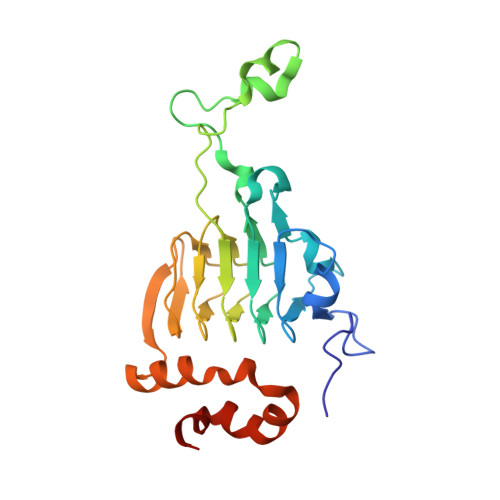Structural Basis of Synercid (Quinupristin-Dalfopristin) Resistance in Gram-positive Bacterial Pathogens
Kehoe, L.E., Snidwongse, J., Courvalin, P., Rafferty, J.B., Murray, I.A.(2003) J Biological Chem 278: 29963-29970
- PubMed: 12771141
- DOI: https://doi.org/10.1074/jbc.M303766200
- Primary Citation of Related Structures:
1MR7, 1MR9, 1MRL - PubMed Abstract:
Synercid, a new semisynthetic streptogramin-derived antibiotic containing dalfopristin and quinupristin, is used in treatment of life-threatening infections caused by glycopeptide-resistant Enterococcus faecium and other bacterial pathogens. However, dissemination of genes encoding virginiamycin acetyltransferases, enzymes that confer resistance to streptogramins, threatens to limit the medical utility of the quinupristin-dalfopristin combination. Here we present structures of virginiamycin acetyltransferase D (VatD) determined at 1.8 A resolution in the absence of ligands, at 2.8 A resolution bound to dalfopristin, and at 3.0 A resolution in the presence of acetyl-coenzyme A. Dalfopristin is bound by VatD in a similar conformation to that described previously for the streptogramin virginiamycin M1. However, specific interactions with the substrate are altered as a consequence of a conformational change in the pyrollidine ring that is propagated to adjacent constituents of the dalfopristin macrocycle. Inactivation of dalfopristin involves acetyl transfer from acetyl-coenzyme A to the sole (O-18) hydroxy group of the antibiotic that lies close to the side chain of the strictly conserved residue, His-82. Replacement of residue 82 by alanine is accompanied by a fall in specific activity of >105-fold, indicating that the imidazole moiety of His-82 is a major determinant of catalytic rate enhancement by VatD. The structure of the VatD-dalfopristin complex can be used to predict positions where further structural modification of the drug might preclude enzyme binding and thereby circumvent Synercid resistance.
- Krebs Institute for Biomolecular Sciences, Department of Molecular Biology and Biotechnology, University of Sheffield, Western Bank, Sheffield S10 2TN, United Kingdom.
Organizational Affiliation:

















